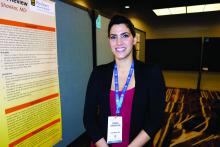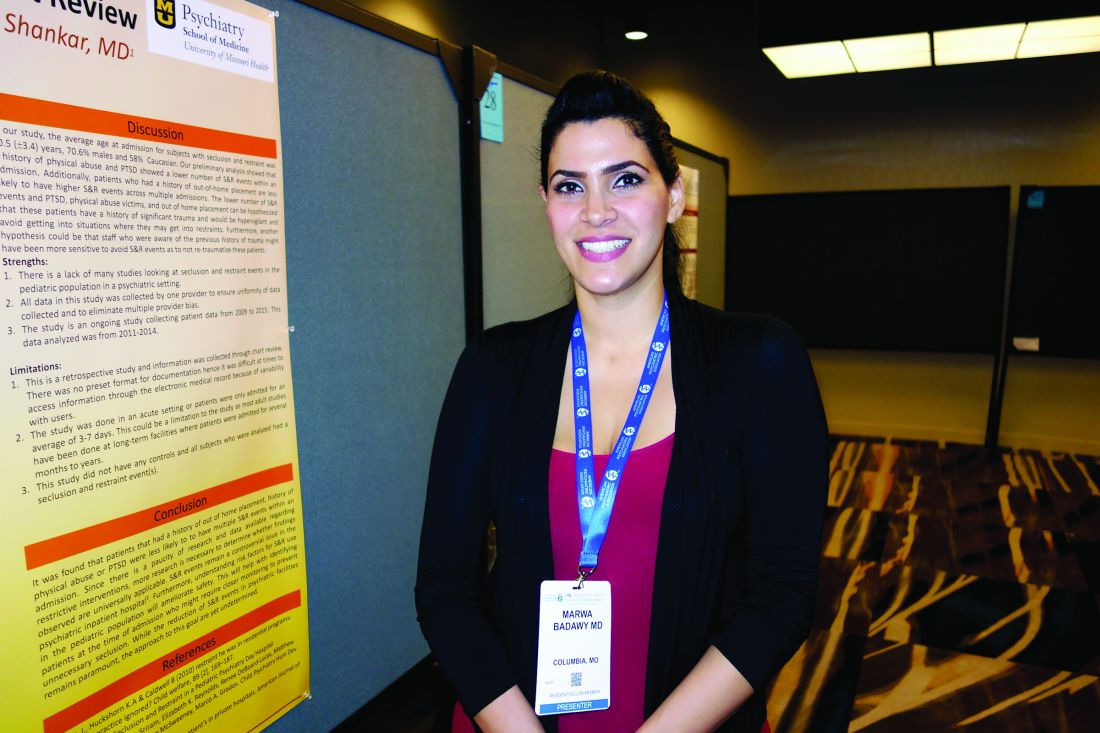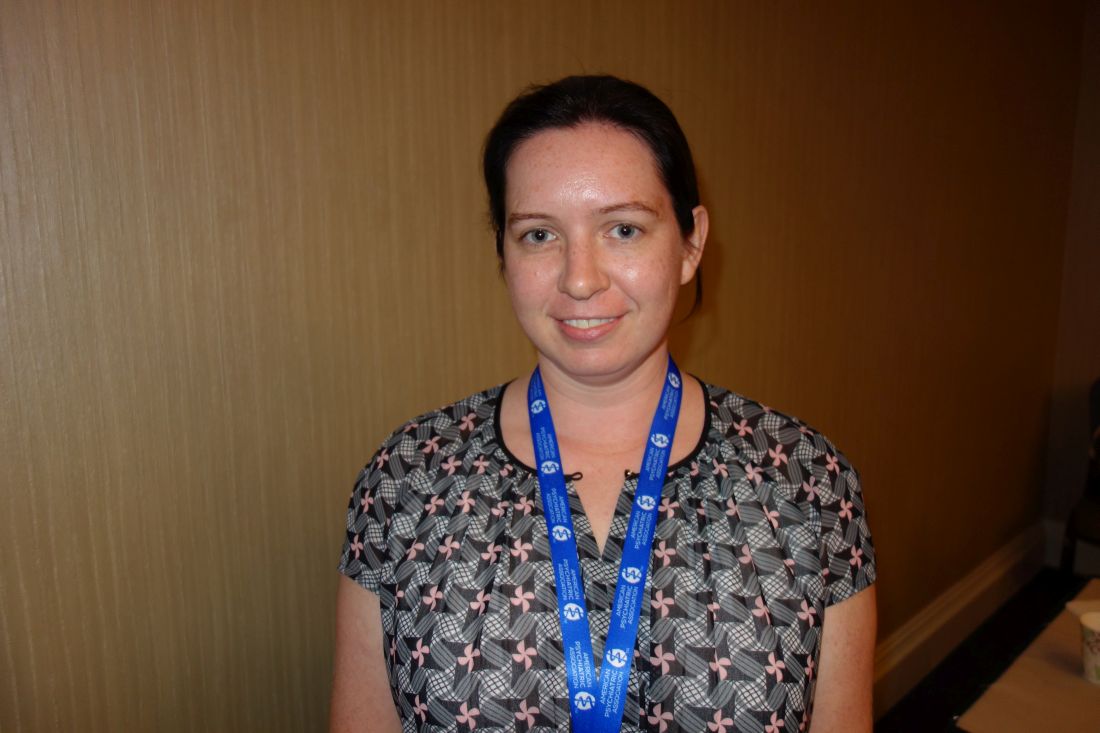User login
Pediatric seclusion and restraint increases with ADHD, decreases with PTSD
NEW ORLEANS – Attention-deficit/hyperactivity disorder and non-suicidal self-harm – cutting and head banging, for instance – strongly predicted longer seclusion and restraint episodes, sometimes past 2 hours, in a review at the University of Missouri, Columbia, pediatric inpatient psychiatric unit.
Meanwhile, children with histories of physical abuse, post-traumatic stress disorder (PTSD), or out-of-home placement were less likely to have multiple seclusion and restraint (SR) episodes during an admission, and had lower numbers of SR events overall. Perhaps hyper-vigilance due to past traumas helped them avoid situations that led to problems. Staff might also have used a lighter touch given the children’s histories.
The investigators reviewed 305 SR episodes from 2011-2014 among 92 children aged 5-18 years old. They plan to expand their study to 2009-2017 and add a prospective arm.
It’s well known that SR, a last-ditch effort to prevent physical harm, traumatizes patients, but research on how to avoid it has mostly focused on adults. The Missouri team wants to change that by identifying the children most at risk, so that something can be done beforehand to prevent it. Maybe extra one-on-one care would help, Dr. Badawy said.
The children in the review were an average of 10.5 years old, and most were admitted for 3-7 days. Fifty-five (60%) had multiple SR episodes, 34 in a single admission and 21 across multiple admissions; 71% of the episodes were in boys, 58% in white children, 27.7% in black children, and the rest in multiracial children. Twenty-one percent of the episodes were in children with intellectual problems. ADHD and oppositional defiant disorder were the most common diagnoses, each diagnosed in more than half of the subjects.
When asked how a 5-year-old child can end up in restraints, Dr. Badawy agreed that bad parenting is a factor. Parents who don’t know any better might escalate normal behavior, and others might simply not care that much about their kids, or have much empathy. “In the 5-10 year-olds, I do think a lot of it is parenting. Neglect is the number one form of abuse,” she said, “and it causes instability in children.”
But parents aren’t always the problem. Dr. Badawy mentioned an “extremely depressed” boy who tried to hang himself again and again, at 8 years old. “His parents were supportive and focused on getting him better,” she said. It’s unknown if anything happened to him when they weren’t around.
If SR is related to children’s own behavior, and if they are able to listen to staff afterward and control it, kids seem able to avoid another episode. Those who have PTSD, or who have been through physical abuse or out-of-home placement, seemed particularly adept in the review.
Avoidance seems less likely, however, when children are set off by other kids.
Sometimes there are clues of impending trouble, like the boy who walked around whistling before he lashed out. Staff at the university quickly learned to swoop in and calm him when they heard the whistling.
The investigators had no industry disclosures.
NEW ORLEANS – Attention-deficit/hyperactivity disorder and non-suicidal self-harm – cutting and head banging, for instance – strongly predicted longer seclusion and restraint episodes, sometimes past 2 hours, in a review at the University of Missouri, Columbia, pediatric inpatient psychiatric unit.
Meanwhile, children with histories of physical abuse, post-traumatic stress disorder (PTSD), or out-of-home placement were less likely to have multiple seclusion and restraint (SR) episodes during an admission, and had lower numbers of SR events overall. Perhaps hyper-vigilance due to past traumas helped them avoid situations that led to problems. Staff might also have used a lighter touch given the children’s histories.
The investigators reviewed 305 SR episodes from 2011-2014 among 92 children aged 5-18 years old. They plan to expand their study to 2009-2017 and add a prospective arm.
It’s well known that SR, a last-ditch effort to prevent physical harm, traumatizes patients, but research on how to avoid it has mostly focused on adults. The Missouri team wants to change that by identifying the children most at risk, so that something can be done beforehand to prevent it. Maybe extra one-on-one care would help, Dr. Badawy said.
The children in the review were an average of 10.5 years old, and most were admitted for 3-7 days. Fifty-five (60%) had multiple SR episodes, 34 in a single admission and 21 across multiple admissions; 71% of the episodes were in boys, 58% in white children, 27.7% in black children, and the rest in multiracial children. Twenty-one percent of the episodes were in children with intellectual problems. ADHD and oppositional defiant disorder were the most common diagnoses, each diagnosed in more than half of the subjects.
When asked how a 5-year-old child can end up in restraints, Dr. Badawy agreed that bad parenting is a factor. Parents who don’t know any better might escalate normal behavior, and others might simply not care that much about their kids, or have much empathy. “In the 5-10 year-olds, I do think a lot of it is parenting. Neglect is the number one form of abuse,” she said, “and it causes instability in children.”
But parents aren’t always the problem. Dr. Badawy mentioned an “extremely depressed” boy who tried to hang himself again and again, at 8 years old. “His parents were supportive and focused on getting him better,” she said. It’s unknown if anything happened to him when they weren’t around.
If SR is related to children’s own behavior, and if they are able to listen to staff afterward and control it, kids seem able to avoid another episode. Those who have PTSD, or who have been through physical abuse or out-of-home placement, seemed particularly adept in the review.
Avoidance seems less likely, however, when children are set off by other kids.
Sometimes there are clues of impending trouble, like the boy who walked around whistling before he lashed out. Staff at the university quickly learned to swoop in and calm him when they heard the whistling.
The investigators had no industry disclosures.
NEW ORLEANS – Attention-deficit/hyperactivity disorder and non-suicidal self-harm – cutting and head banging, for instance – strongly predicted longer seclusion and restraint episodes, sometimes past 2 hours, in a review at the University of Missouri, Columbia, pediatric inpatient psychiatric unit.
Meanwhile, children with histories of physical abuse, post-traumatic stress disorder (PTSD), or out-of-home placement were less likely to have multiple seclusion and restraint (SR) episodes during an admission, and had lower numbers of SR events overall. Perhaps hyper-vigilance due to past traumas helped them avoid situations that led to problems. Staff might also have used a lighter touch given the children’s histories.
The investigators reviewed 305 SR episodes from 2011-2014 among 92 children aged 5-18 years old. They plan to expand their study to 2009-2017 and add a prospective arm.
It’s well known that SR, a last-ditch effort to prevent physical harm, traumatizes patients, but research on how to avoid it has mostly focused on adults. The Missouri team wants to change that by identifying the children most at risk, so that something can be done beforehand to prevent it. Maybe extra one-on-one care would help, Dr. Badawy said.
The children in the review were an average of 10.5 years old, and most were admitted for 3-7 days. Fifty-five (60%) had multiple SR episodes, 34 in a single admission and 21 across multiple admissions; 71% of the episodes were in boys, 58% in white children, 27.7% in black children, and the rest in multiracial children. Twenty-one percent of the episodes were in children with intellectual problems. ADHD and oppositional defiant disorder were the most common diagnoses, each diagnosed in more than half of the subjects.
When asked how a 5-year-old child can end up in restraints, Dr. Badawy agreed that bad parenting is a factor. Parents who don’t know any better might escalate normal behavior, and others might simply not care that much about their kids, or have much empathy. “In the 5-10 year-olds, I do think a lot of it is parenting. Neglect is the number one form of abuse,” she said, “and it causes instability in children.”
But parents aren’t always the problem. Dr. Badawy mentioned an “extremely depressed” boy who tried to hang himself again and again, at 8 years old. “His parents were supportive and focused on getting him better,” she said. It’s unknown if anything happened to him when they weren’t around.
If SR is related to children’s own behavior, and if they are able to listen to staff afterward and control it, kids seem able to avoid another episode. Those who have PTSD, or who have been through physical abuse or out-of-home placement, seemed particularly adept in the review.
Avoidance seems less likely, however, when children are set off by other kids.
Sometimes there are clues of impending trouble, like the boy who walked around whistling before he lashed out. Staff at the university quickly learned to swoop in and calm him when they heard the whistling.
The investigators had no industry disclosures.
AT IPS 2017
Key clinical point:
Major finding: ADHD and non-suicidal self-harm – cutting and head banging – strongly predict longer seclusion and restraint episodes, sometimes past 2 hours.
Data source: A University of Missouri, Columbia, review of 305 seclusion and restraint episodes from 2011-2014 among 92 children aged 5-18 years old.
Disclosures: The investigators had no industry disclosures.
Recommend high CBD, low THC products to marijuana-using patients with psychosis
NEW ORLEANS – Marijuana and psychosis don’t mix, according to Erica Rapp, MD, an assistant professor of psychiatry at the University of Colorado Anschutz Medical Campus, Aurora.
Regular use is associated with increased positive psychotic symptoms, a wide-range of poor psycho-social outcomes, reduced medication adherence, and a higher rate of relapse that’s not entirely explained by reduced adherence. One study even found an increased risk of suicide, she said at the American Psychiatric Association’s Institute on Psychiatric Services meeting.
Epidemiological studies, meanwhile, have found a “robust” association between regular marijuana use and an increased risk of schizophrenia, about two-times higher in the general population and about four-times higher in people who are predisposed to psychosis. It’s possible that marijuana doesn’t actually increase the rate of psychotic disorders, but just makes them come on sooner. “While that is almost certainly true, it doesn’t exclude the overall increased risk,” Dr. Rapp said.
Researchers are working to unravel the cross-talk between marijuana and psychosis. It seems that with heavy, regular use, you “are basically loading your brain with dopamine; [perhaps] people become more sensitized to dopamine-induced perceptual and cognitive problems,” she said.
“Luckily, if we can get people to stop use early in the course of their psychotic illness, they do much better. There are improvements in mood, anxiety, positive psychotic symptoms, medication adherence, and global functioning,” she said.
It’s not easy to get people to stop, however.
The notion of “marijuana as a potent cause of schizophrenia ... is something that users do not like to hear.” Many consider marijuana “a medicine, and that if they smoke it, they are going to be healthier. If you suggest that” marijuana might do “some bad things in addition to all the great things they think it’s doing, they immediately think you are a narc, and shut down. It’s hard to have an open conversion,” Dr. Rapp said.
At this point, it seems that it’s the tetrahydrocannabinol (THC) in marijuana that causes problems for people who have or who are prone to psychosis, and that it’s the cannabidiol (CBD) component that’s responsible for the therapeutic effects. CBD appears to be a dopamine D2 receptor antagonist, and some small pilot studies have found anti-psychotic effects. “CBD actually has some potential as a treatment” for psychosis, especially for negative symptoms, she said.
So, when abstinence isn’t an option, “I try to steer people towards CBD, rather than THC. Labels in dispensaries tell you what the THC and CBD content are. Those can be really unreliable, but it’s something.” Staff can point out high CBD products. “I also usually caution against smoking. I tell people that smoking anything has bad effects on your health,” she said. Edibles are among the many alternative formulations.
Patients who are truly interested in therapeutic benefits appreciate the message. “If they say, ‘oh, that doesn’t sound like fun,’ it tells me they are really looking for the psychoactive THC high,” she said.
Dr. Rapp did not have any industry disclosures.
NEW ORLEANS – Marijuana and psychosis don’t mix, according to Erica Rapp, MD, an assistant professor of psychiatry at the University of Colorado Anschutz Medical Campus, Aurora.
Regular use is associated with increased positive psychotic symptoms, a wide-range of poor psycho-social outcomes, reduced medication adherence, and a higher rate of relapse that’s not entirely explained by reduced adherence. One study even found an increased risk of suicide, she said at the American Psychiatric Association’s Institute on Psychiatric Services meeting.
Epidemiological studies, meanwhile, have found a “robust” association between regular marijuana use and an increased risk of schizophrenia, about two-times higher in the general population and about four-times higher in people who are predisposed to psychosis. It’s possible that marijuana doesn’t actually increase the rate of psychotic disorders, but just makes them come on sooner. “While that is almost certainly true, it doesn’t exclude the overall increased risk,” Dr. Rapp said.
Researchers are working to unravel the cross-talk between marijuana and psychosis. It seems that with heavy, regular use, you “are basically loading your brain with dopamine; [perhaps] people become more sensitized to dopamine-induced perceptual and cognitive problems,” she said.
“Luckily, if we can get people to stop use early in the course of their psychotic illness, they do much better. There are improvements in mood, anxiety, positive psychotic symptoms, medication adherence, and global functioning,” she said.
It’s not easy to get people to stop, however.
The notion of “marijuana as a potent cause of schizophrenia ... is something that users do not like to hear.” Many consider marijuana “a medicine, and that if they smoke it, they are going to be healthier. If you suggest that” marijuana might do “some bad things in addition to all the great things they think it’s doing, they immediately think you are a narc, and shut down. It’s hard to have an open conversion,” Dr. Rapp said.
At this point, it seems that it’s the tetrahydrocannabinol (THC) in marijuana that causes problems for people who have or who are prone to psychosis, and that it’s the cannabidiol (CBD) component that’s responsible for the therapeutic effects. CBD appears to be a dopamine D2 receptor antagonist, and some small pilot studies have found anti-psychotic effects. “CBD actually has some potential as a treatment” for psychosis, especially for negative symptoms, she said.
So, when abstinence isn’t an option, “I try to steer people towards CBD, rather than THC. Labels in dispensaries tell you what the THC and CBD content are. Those can be really unreliable, but it’s something.” Staff can point out high CBD products. “I also usually caution against smoking. I tell people that smoking anything has bad effects on your health,” she said. Edibles are among the many alternative formulations.
Patients who are truly interested in therapeutic benefits appreciate the message. “If they say, ‘oh, that doesn’t sound like fun,’ it tells me they are really looking for the psychoactive THC high,” she said.
Dr. Rapp did not have any industry disclosures.
NEW ORLEANS – Marijuana and psychosis don’t mix, according to Erica Rapp, MD, an assistant professor of psychiatry at the University of Colorado Anschutz Medical Campus, Aurora.
Regular use is associated with increased positive psychotic symptoms, a wide-range of poor psycho-social outcomes, reduced medication adherence, and a higher rate of relapse that’s not entirely explained by reduced adherence. One study even found an increased risk of suicide, she said at the American Psychiatric Association’s Institute on Psychiatric Services meeting.
Epidemiological studies, meanwhile, have found a “robust” association between regular marijuana use and an increased risk of schizophrenia, about two-times higher in the general population and about four-times higher in people who are predisposed to psychosis. It’s possible that marijuana doesn’t actually increase the rate of psychotic disorders, but just makes them come on sooner. “While that is almost certainly true, it doesn’t exclude the overall increased risk,” Dr. Rapp said.
Researchers are working to unravel the cross-talk between marijuana and psychosis. It seems that with heavy, regular use, you “are basically loading your brain with dopamine; [perhaps] people become more sensitized to dopamine-induced perceptual and cognitive problems,” she said.
“Luckily, if we can get people to stop use early in the course of their psychotic illness, they do much better. There are improvements in mood, anxiety, positive psychotic symptoms, medication adherence, and global functioning,” she said.
It’s not easy to get people to stop, however.
The notion of “marijuana as a potent cause of schizophrenia ... is something that users do not like to hear.” Many consider marijuana “a medicine, and that if they smoke it, they are going to be healthier. If you suggest that” marijuana might do “some bad things in addition to all the great things they think it’s doing, they immediately think you are a narc, and shut down. It’s hard to have an open conversion,” Dr. Rapp said.
At this point, it seems that it’s the tetrahydrocannabinol (THC) in marijuana that causes problems for people who have or who are prone to psychosis, and that it’s the cannabidiol (CBD) component that’s responsible for the therapeutic effects. CBD appears to be a dopamine D2 receptor antagonist, and some small pilot studies have found anti-psychotic effects. “CBD actually has some potential as a treatment” for psychosis, especially for negative symptoms, she said.
So, when abstinence isn’t an option, “I try to steer people towards CBD, rather than THC. Labels in dispensaries tell you what the THC and CBD content are. Those can be really unreliable, but it’s something.” Staff can point out high CBD products. “I also usually caution against smoking. I tell people that smoking anything has bad effects on your health,” she said. Edibles are among the many alternative formulations.
Patients who are truly interested in therapeutic benefits appreciate the message. “If they say, ‘oh, that doesn’t sound like fun,’ it tells me they are really looking for the psychoactive THC high,” she said.
Dr. Rapp did not have any industry disclosures.
AT IPS 2017
ECT patients do better when families attend sessions
NEW ORLEANS – In 2001, a patient at the Menninger Clinic, Houston, asked whether her husband could be with her during ECT treatments, so she’d feel safer.
He declined, but then she told her care team “the fact that you would allow that makes me feel entirely safe now,” recalled M. Justin Coffey, MD, medical director of Menninger’s Center for Brain Stimulation.
“She made her request partly in jest, but it was a great idea,” he said. Fast-forward 16 years, and it’s now standard practice at Menninger for patients to invite loved ones to ECT sessions. Sometimes they pick family members, other times a neighbor or even a pastor.
“One of the most powerful benefits we’ve seen is that the loved ones observing the treatment become thoroughly underwhelmed by what they see,” not much more than the patient under anesthesia. “At the same time, they are incredibly impressed by the expertise and competence of the team. They become ambassadors against stigma; I’ve got family members and patients now that join me in workshops talking about why ECT should be [used] more,” Dr. Coffey said at the American Psychiatric Association’s Institute on Psychiatric Services.
The approach is catching on, including at the New York Community Hospital, Brooklyn, where it was implemented a few years ago. “It’s a wonderful thing to decrease patient anxiety and the stigma of treatment. You ask the patient’s permission, of course, and discuss with the family members what they are going to see. It demystifies the whole thing,” said Charles H. Kellner, MD, chief of electroconvulsive therapy at the hospital and a well-known ECT researcher.
Another benefit they’ve seen at Menninger is that patients come out of their postictal confusion sooner when there’s a familiar, comforting person in the room. That’s important, because the quicker patients reorient, the less likely they are to have retrograde memory problems, Dr. Coffey said.
Memory loss is perhaps the top fear people have about ECT, and it leads to the underuse of an otherwise safe and effective treatment for severe, refractory depression. Anterograde memory problems generally clear up in a few days, but retrograde problems can linger; memories formed within 3-6 months of ECT are the most vulnerable. It’s tough to pin down exactly how great the risk is because of variations in how ECT is performed from one center to the next.
“It’s always a risk-benefit decision,” Dr. Kellner said. “The vast majority of patients do not have profound memory trouble with ECT; it’s a temporary nuisance. I’d say maybe 10% or fewer have memory problems significant enough to stop treatment, or that really bother them.”
“The most important thing” when counseling patients “is not to promise anything, because you really don’t know how an individual is going to respond to ECT,” said Adriana P. Hermida, MD, a geriatric psychiatrist and ECT practitioner at Emory University, Atlanta.
In general, cognitive problems and memory loss are less likely with unilateral treatment than with bilateral, and least likely with ultra-brief unilateral treatment. Two sessions per week are less likely to cause problems than are the usual three, but treatment response isn’t as rapid. Also, giving more than two seizures per session increases the risk of medical and cognitive side effects, and isn’t recommended.
To manage the memory risk, cognitive function should be assessed before each session, not just by objective measures and patient report, but also by asking family members what they’ve noticed. “Many times patient do not report memory issues, but family members will,” Dr. Hermida said.
If there’s a problem, patients can switch to two sessions per week, for instance, or to ultra-brief unilateral ECT.
A few studies have suggested that cholinesterase inhibitors and memantine (Namenda) might attenuate cognitive side effects, but there’s not enough evidence to recommend their use, she said.
The speakers had no relevant industry disclosures.
NEW ORLEANS – In 2001, a patient at the Menninger Clinic, Houston, asked whether her husband could be with her during ECT treatments, so she’d feel safer.
He declined, but then she told her care team “the fact that you would allow that makes me feel entirely safe now,” recalled M. Justin Coffey, MD, medical director of Menninger’s Center for Brain Stimulation.
“She made her request partly in jest, but it was a great idea,” he said. Fast-forward 16 years, and it’s now standard practice at Menninger for patients to invite loved ones to ECT sessions. Sometimes they pick family members, other times a neighbor or even a pastor.
“One of the most powerful benefits we’ve seen is that the loved ones observing the treatment become thoroughly underwhelmed by what they see,” not much more than the patient under anesthesia. “At the same time, they are incredibly impressed by the expertise and competence of the team. They become ambassadors against stigma; I’ve got family members and patients now that join me in workshops talking about why ECT should be [used] more,” Dr. Coffey said at the American Psychiatric Association’s Institute on Psychiatric Services.
The approach is catching on, including at the New York Community Hospital, Brooklyn, where it was implemented a few years ago. “It’s a wonderful thing to decrease patient anxiety and the stigma of treatment. You ask the patient’s permission, of course, and discuss with the family members what they are going to see. It demystifies the whole thing,” said Charles H. Kellner, MD, chief of electroconvulsive therapy at the hospital and a well-known ECT researcher.
Another benefit they’ve seen at Menninger is that patients come out of their postictal confusion sooner when there’s a familiar, comforting person in the room. That’s important, because the quicker patients reorient, the less likely they are to have retrograde memory problems, Dr. Coffey said.
Memory loss is perhaps the top fear people have about ECT, and it leads to the underuse of an otherwise safe and effective treatment for severe, refractory depression. Anterograde memory problems generally clear up in a few days, but retrograde problems can linger; memories formed within 3-6 months of ECT are the most vulnerable. It’s tough to pin down exactly how great the risk is because of variations in how ECT is performed from one center to the next.
“It’s always a risk-benefit decision,” Dr. Kellner said. “The vast majority of patients do not have profound memory trouble with ECT; it’s a temporary nuisance. I’d say maybe 10% or fewer have memory problems significant enough to stop treatment, or that really bother them.”
“The most important thing” when counseling patients “is not to promise anything, because you really don’t know how an individual is going to respond to ECT,” said Adriana P. Hermida, MD, a geriatric psychiatrist and ECT practitioner at Emory University, Atlanta.
In general, cognitive problems and memory loss are less likely with unilateral treatment than with bilateral, and least likely with ultra-brief unilateral treatment. Two sessions per week are less likely to cause problems than are the usual three, but treatment response isn’t as rapid. Also, giving more than two seizures per session increases the risk of medical and cognitive side effects, and isn’t recommended.
To manage the memory risk, cognitive function should be assessed before each session, not just by objective measures and patient report, but also by asking family members what they’ve noticed. “Many times patient do not report memory issues, but family members will,” Dr. Hermida said.
If there’s a problem, patients can switch to two sessions per week, for instance, or to ultra-brief unilateral ECT.
A few studies have suggested that cholinesterase inhibitors and memantine (Namenda) might attenuate cognitive side effects, but there’s not enough evidence to recommend their use, she said.
The speakers had no relevant industry disclosures.
NEW ORLEANS – In 2001, a patient at the Menninger Clinic, Houston, asked whether her husband could be with her during ECT treatments, so she’d feel safer.
He declined, but then she told her care team “the fact that you would allow that makes me feel entirely safe now,” recalled M. Justin Coffey, MD, medical director of Menninger’s Center for Brain Stimulation.
“She made her request partly in jest, but it was a great idea,” he said. Fast-forward 16 years, and it’s now standard practice at Menninger for patients to invite loved ones to ECT sessions. Sometimes they pick family members, other times a neighbor or even a pastor.
“One of the most powerful benefits we’ve seen is that the loved ones observing the treatment become thoroughly underwhelmed by what they see,” not much more than the patient under anesthesia. “At the same time, they are incredibly impressed by the expertise and competence of the team. They become ambassadors against stigma; I’ve got family members and patients now that join me in workshops talking about why ECT should be [used] more,” Dr. Coffey said at the American Psychiatric Association’s Institute on Psychiatric Services.
The approach is catching on, including at the New York Community Hospital, Brooklyn, where it was implemented a few years ago. “It’s a wonderful thing to decrease patient anxiety and the stigma of treatment. You ask the patient’s permission, of course, and discuss with the family members what they are going to see. It demystifies the whole thing,” said Charles H. Kellner, MD, chief of electroconvulsive therapy at the hospital and a well-known ECT researcher.
Another benefit they’ve seen at Menninger is that patients come out of their postictal confusion sooner when there’s a familiar, comforting person in the room. That’s important, because the quicker patients reorient, the less likely they are to have retrograde memory problems, Dr. Coffey said.
Memory loss is perhaps the top fear people have about ECT, and it leads to the underuse of an otherwise safe and effective treatment for severe, refractory depression. Anterograde memory problems generally clear up in a few days, but retrograde problems can linger; memories formed within 3-6 months of ECT are the most vulnerable. It’s tough to pin down exactly how great the risk is because of variations in how ECT is performed from one center to the next.
“It’s always a risk-benefit decision,” Dr. Kellner said. “The vast majority of patients do not have profound memory trouble with ECT; it’s a temporary nuisance. I’d say maybe 10% or fewer have memory problems significant enough to stop treatment, or that really bother them.”
“The most important thing” when counseling patients “is not to promise anything, because you really don’t know how an individual is going to respond to ECT,” said Adriana P. Hermida, MD, a geriatric psychiatrist and ECT practitioner at Emory University, Atlanta.
In general, cognitive problems and memory loss are less likely with unilateral treatment than with bilateral, and least likely with ultra-brief unilateral treatment. Two sessions per week are less likely to cause problems than are the usual three, but treatment response isn’t as rapid. Also, giving more than two seizures per session increases the risk of medical and cognitive side effects, and isn’t recommended.
To manage the memory risk, cognitive function should be assessed before each session, not just by objective measures and patient report, but also by asking family members what they’ve noticed. “Many times patient do not report memory issues, but family members will,” Dr. Hermida said.
If there’s a problem, patients can switch to two sessions per week, for instance, or to ultra-brief unilateral ECT.
A few studies have suggested that cholinesterase inhibitors and memantine (Namenda) might attenuate cognitive side effects, but there’s not enough evidence to recommend their use, she said.
The speakers had no relevant industry disclosures.
EXPERT ANALYSIS FROM IPS 2017
Home induction viewed as OK with Suboxone
NEW ORLEANS – About half the patients who arrive for opioid addiction treatment at Community Mental Health Affiliates in New Britain, Conn., already have buprenorphine in their urine, according to staff psychiatrist Margaret Chaplin, MD.
“There’s a huge black market for Suboxone right now, not so much because people want to abuse it to get high, but because there’s recognition” on the street that it helps with addiction. “It seems kind of silly to do” a witnessed induction “when people are already on the medication, and there’s lot of data that show home induction is just as safe,” she said at the American Psychiatric Association’s Institute on Psychiatric Services.
Plus, “if somebody comes in and they have an opiate” in their pocket, “I am afraid that they won’t make it through the night. I’ll send them home with a script and see them the next day,” she said.
Witnessed inductions were recommended when Suboxone was approved in 2002 in case of side effects, but fatal overdose is unlikely. Other addiction specialists in Dr. Chaplin’s audience said they now feel comfortable with home induction, as well.
To prevent problems, patients need to be either completely opioid free or in withdrawal, which usually starts about 12 hours after the last heroin dose. Most will need to be titrated up to about 16 mg/d. Some will need more, but Dr. Chaplin caps it at 24 mg, because of the diversion risk and the dearth of evidence showing additional benefit with higher doses.
The clinic checks urine norbuprenorphine, a metabolite of buprenorphine, for adherence. “All you have to do to get a buprenorphine positive urine is dip a Suboxone strip in [it], but only the human liver makes norbuprenorphine. If it’s there, we have a pretty good sense that they are taking their Suboxone,” she said.
The clinic doesn’t use the new buprenorphine implant (Probuphine), because it’s limited to people who are stable on just 8 mg buprenorphine daily, and the requirement for surgical implant and removal is a problem for clinic patients, who are sometimes homeless.
Naltrexone isn’t used much, either; the risk of fatal overdose is too high when patients come off it, and there’s not much incentive to stay on it. Patients can’t feel it work, like with methadone and Suboxone, and there’s no continuity with doing heroin. When naltrexone is used, Dr. Chaplin opts for the monthly IM formulation (Vivitrol) instead of daily tablets. With the shot, “you don’t need resolve as long as you come back and get a second injection.” IM naltrexone does help with the cravings, she noted, but not until about the third or fourth shot.
A lot of people hope to eventually come off medications such as Suboxone, but that’s dangerous thinking, Dr. Chaplin said.
One of her patients was buprenorphine free for several years. His wife went to the ED for an injury and returned with a bottle of Percocet, his drug of choice. “He heard the pills jiggling around in the bottle,” and that was all it took; he downed the whole thing. “He’s back on Suboxone now, and we don’t have any intention to take him off,” she said.
“I don’t think we should have as our goal to be off treatment. I think we should have as our goal to be alive and well, and managing our lives,” she said. “I’d rather see someone continue on 1 or 2 mg of Suboxone and be protected and feel normal” than come off it.
Also, people in treatment should have naloxone nasal spray (Narcan) on hand, just in case, she said.
Dr. Chaplin had no disclosures.
NEW ORLEANS – About half the patients who arrive for opioid addiction treatment at Community Mental Health Affiliates in New Britain, Conn., already have buprenorphine in their urine, according to staff psychiatrist Margaret Chaplin, MD.
“There’s a huge black market for Suboxone right now, not so much because people want to abuse it to get high, but because there’s recognition” on the street that it helps with addiction. “It seems kind of silly to do” a witnessed induction “when people are already on the medication, and there’s lot of data that show home induction is just as safe,” she said at the American Psychiatric Association’s Institute on Psychiatric Services.
Plus, “if somebody comes in and they have an opiate” in their pocket, “I am afraid that they won’t make it through the night. I’ll send them home with a script and see them the next day,” she said.
Witnessed inductions were recommended when Suboxone was approved in 2002 in case of side effects, but fatal overdose is unlikely. Other addiction specialists in Dr. Chaplin’s audience said they now feel comfortable with home induction, as well.
To prevent problems, patients need to be either completely opioid free or in withdrawal, which usually starts about 12 hours after the last heroin dose. Most will need to be titrated up to about 16 mg/d. Some will need more, but Dr. Chaplin caps it at 24 mg, because of the diversion risk and the dearth of evidence showing additional benefit with higher doses.
The clinic checks urine norbuprenorphine, a metabolite of buprenorphine, for adherence. “All you have to do to get a buprenorphine positive urine is dip a Suboxone strip in [it], but only the human liver makes norbuprenorphine. If it’s there, we have a pretty good sense that they are taking their Suboxone,” she said.
The clinic doesn’t use the new buprenorphine implant (Probuphine), because it’s limited to people who are stable on just 8 mg buprenorphine daily, and the requirement for surgical implant and removal is a problem for clinic patients, who are sometimes homeless.
Naltrexone isn’t used much, either; the risk of fatal overdose is too high when patients come off it, and there’s not much incentive to stay on it. Patients can’t feel it work, like with methadone and Suboxone, and there’s no continuity with doing heroin. When naltrexone is used, Dr. Chaplin opts for the monthly IM formulation (Vivitrol) instead of daily tablets. With the shot, “you don’t need resolve as long as you come back and get a second injection.” IM naltrexone does help with the cravings, she noted, but not until about the third or fourth shot.
A lot of people hope to eventually come off medications such as Suboxone, but that’s dangerous thinking, Dr. Chaplin said.
One of her patients was buprenorphine free for several years. His wife went to the ED for an injury and returned with a bottle of Percocet, his drug of choice. “He heard the pills jiggling around in the bottle,” and that was all it took; he downed the whole thing. “He’s back on Suboxone now, and we don’t have any intention to take him off,” she said.
“I don’t think we should have as our goal to be off treatment. I think we should have as our goal to be alive and well, and managing our lives,” she said. “I’d rather see someone continue on 1 or 2 mg of Suboxone and be protected and feel normal” than come off it.
Also, people in treatment should have naloxone nasal spray (Narcan) on hand, just in case, she said.
Dr. Chaplin had no disclosures.
NEW ORLEANS – About half the patients who arrive for opioid addiction treatment at Community Mental Health Affiliates in New Britain, Conn., already have buprenorphine in their urine, according to staff psychiatrist Margaret Chaplin, MD.
“There’s a huge black market for Suboxone right now, not so much because people want to abuse it to get high, but because there’s recognition” on the street that it helps with addiction. “It seems kind of silly to do” a witnessed induction “when people are already on the medication, and there’s lot of data that show home induction is just as safe,” she said at the American Psychiatric Association’s Institute on Psychiatric Services.
Plus, “if somebody comes in and they have an opiate” in their pocket, “I am afraid that they won’t make it through the night. I’ll send them home with a script and see them the next day,” she said.
Witnessed inductions were recommended when Suboxone was approved in 2002 in case of side effects, but fatal overdose is unlikely. Other addiction specialists in Dr. Chaplin’s audience said they now feel comfortable with home induction, as well.
To prevent problems, patients need to be either completely opioid free or in withdrawal, which usually starts about 12 hours after the last heroin dose. Most will need to be titrated up to about 16 mg/d. Some will need more, but Dr. Chaplin caps it at 24 mg, because of the diversion risk and the dearth of evidence showing additional benefit with higher doses.
The clinic checks urine norbuprenorphine, a metabolite of buprenorphine, for adherence. “All you have to do to get a buprenorphine positive urine is dip a Suboxone strip in [it], but only the human liver makes norbuprenorphine. If it’s there, we have a pretty good sense that they are taking their Suboxone,” she said.
The clinic doesn’t use the new buprenorphine implant (Probuphine), because it’s limited to people who are stable on just 8 mg buprenorphine daily, and the requirement for surgical implant and removal is a problem for clinic patients, who are sometimes homeless.
Naltrexone isn’t used much, either; the risk of fatal overdose is too high when patients come off it, and there’s not much incentive to stay on it. Patients can’t feel it work, like with methadone and Suboxone, and there’s no continuity with doing heroin. When naltrexone is used, Dr. Chaplin opts for the monthly IM formulation (Vivitrol) instead of daily tablets. With the shot, “you don’t need resolve as long as you come back and get a second injection.” IM naltrexone does help with the cravings, she noted, but not until about the third or fourth shot.
A lot of people hope to eventually come off medications such as Suboxone, but that’s dangerous thinking, Dr. Chaplin said.
One of her patients was buprenorphine free for several years. His wife went to the ED for an injury and returned with a bottle of Percocet, his drug of choice. “He heard the pills jiggling around in the bottle,” and that was all it took; he downed the whole thing. “He’s back on Suboxone now, and we don’t have any intention to take him off,” she said.
“I don’t think we should have as our goal to be off treatment. I think we should have as our goal to be alive and well, and managing our lives,” she said. “I’d rather see someone continue on 1 or 2 mg of Suboxone and be protected and feel normal” than come off it.
Also, people in treatment should have naloxone nasal spray (Narcan) on hand, just in case, she said.
Dr. Chaplin had no disclosures.
EXPERT ANALYSIS FROM IPS 2017
VIDEO: How to manage surgical pain in opioid addiction treatment
NEW ORLEANS – How do you manage surgical pain when someone is in treatment for opioid addiction? And how do you manage chronic pain?
It is possible to give patients opioids for post-op pain without increasing the risk of relapse, according to Margaret Chaplin, MD, a staff psychiatrist at Community Mental Health Affiliates in New Britain, Conn.
Dr. Chaplin generally uses buprenorphine and naloxone (Suboxone) for opioid use disorder, and she likes to keep her patients on it for surgery. That often means, however, talking with skeptical surgeons and anesthesiologists beforehand, and reminding them that buprenorphine itself has analgesic effects. Meanwhile, when her patients have chronic pain, sometimes they need help understanding that aspirin and acetaminophen help, even if they don’t give patients a warm, fuzzy feeling.
Dr. Chaplin shared those tips and more about pain management in opioid addiction in an interview at the American Psychiatric Association’s Institute on Psychiatric Services.
NEW ORLEANS – How do you manage surgical pain when someone is in treatment for opioid addiction? And how do you manage chronic pain?
It is possible to give patients opioids for post-op pain without increasing the risk of relapse, according to Margaret Chaplin, MD, a staff psychiatrist at Community Mental Health Affiliates in New Britain, Conn.
Dr. Chaplin generally uses buprenorphine and naloxone (Suboxone) for opioid use disorder, and she likes to keep her patients on it for surgery. That often means, however, talking with skeptical surgeons and anesthesiologists beforehand, and reminding them that buprenorphine itself has analgesic effects. Meanwhile, when her patients have chronic pain, sometimes they need help understanding that aspirin and acetaminophen help, even if they don’t give patients a warm, fuzzy feeling.
Dr. Chaplin shared those tips and more about pain management in opioid addiction in an interview at the American Psychiatric Association’s Institute on Psychiatric Services.
NEW ORLEANS – How do you manage surgical pain when someone is in treatment for opioid addiction? And how do you manage chronic pain?
It is possible to give patients opioids for post-op pain without increasing the risk of relapse, according to Margaret Chaplin, MD, a staff psychiatrist at Community Mental Health Affiliates in New Britain, Conn.
Dr. Chaplin generally uses buprenorphine and naloxone (Suboxone) for opioid use disorder, and she likes to keep her patients on it for surgery. That often means, however, talking with skeptical surgeons and anesthesiologists beforehand, and reminding them that buprenorphine itself has analgesic effects. Meanwhile, when her patients have chronic pain, sometimes they need help understanding that aspirin and acetaminophen help, even if they don’t give patients a warm, fuzzy feeling.
Dr. Chaplin shared those tips and more about pain management in opioid addiction in an interview at the American Psychiatric Association’s Institute on Psychiatric Services.
AT IPS 2017
Use MADRS to dose ketamine for refractory depression
NEW ORLEANS – Ketamine infusions are becoming more and more routine for refractory depression, but the literature is just not clear about the optimal treatment regimen.
Studies have run the gamut from daily, to weekly, to monthly infusions, with scant information on how to predict who will respond and how to maintain response.
“Almost everybody feels significantly better an hour after the infusion. The question is how long will they continue to feel better, and how to find the ones who will stay well. That’s what we’ve tried to answer here,” said principal investigator and psychiatrist Ranjith Chandrasena, MD, the research center’s scientific director.
Ketamine is dosed at 0.5 mg/kg IV over 45 minutes, delivered in an ambulatory care center under the supervision of a respiratory therapist and a physician assistant, with vital signs monitored every 10 minutes. Patients are cleared ahead of time for anesthesia, since ketamine at higher doses is an anesthetic.
In the induction phase, patients are offered up to three ketamine infusions weekly; if MADRS scores don’t remain below 16 points a month after the last induction dose, ketamine is judged to be ineffective, and the patient is taken off the protocol. A score below 16 “pretty much translates to normal functioning,” Dr. Chandrasena said.
Patients who remain below 16 points a month after their last induction dose are moved onto maintenance and qualify for repeat infusions when their MADRS creeps above 16 points, so long as it’s stayed below 16 for a month or more in the interim. The majority of patients on maintenance go 6 or more weeks between infusions. MADRS scores are assessed weekly over the phone.
For patients on maintenance, scores have dropped from a mean of 28.72 points at baseline to 10.73 points, an impressive improvement in patients with long-standing depression who have failed multiple treatments.
Global Assessment of Functioning scores have improved as well, from a baseline of under 40 points to over 60 points, with improvements in social functioning and the ability to work. A few patients had made serious suicide attempts before starting ketamine; with treatment, “there has been success in keeping patients out of the hospital, with no suicide attempts reported,” Dr. Chandrasena said.
Ketamine’s been well tolerated at the center; no one has been discontinued because of side effects, and only one person has had noticeable hallucinations. “People are telling us that it’s a very pleasant experience,” he said.
But to cut costs and reduce the addiction risk, the investigators are considering nasal esketamine instead of IV ketamine, and rapastinel, an N-methyl-d-aspartate receptor antagonist that doesn’t have the dissociative effects of ketamine. Patients also are being taught how to recognize the signs of relapse, to see whether the medication reduces the need for weekly phone assessments.
“We would like someone to replicate our study. If the results are promising, that would be the time to do a double-blind placebo-controlled trial using this” protocol, Dr. Chandrasena said.
Almost two-thirds of the subjects were women, about a third were men, and a few were transgendered. Ages ranged from 19 to above 70 years, with most patients 30-70 years old.
There was no industry funding for the work, and the investigators had no disclosures.
NEW ORLEANS – Ketamine infusions are becoming more and more routine for refractory depression, but the literature is just not clear about the optimal treatment regimen.
Studies have run the gamut from daily, to weekly, to monthly infusions, with scant information on how to predict who will respond and how to maintain response.
“Almost everybody feels significantly better an hour after the infusion. The question is how long will they continue to feel better, and how to find the ones who will stay well. That’s what we’ve tried to answer here,” said principal investigator and psychiatrist Ranjith Chandrasena, MD, the research center’s scientific director.
Ketamine is dosed at 0.5 mg/kg IV over 45 minutes, delivered in an ambulatory care center under the supervision of a respiratory therapist and a physician assistant, with vital signs monitored every 10 minutes. Patients are cleared ahead of time for anesthesia, since ketamine at higher doses is an anesthetic.
In the induction phase, patients are offered up to three ketamine infusions weekly; if MADRS scores don’t remain below 16 points a month after the last induction dose, ketamine is judged to be ineffective, and the patient is taken off the protocol. A score below 16 “pretty much translates to normal functioning,” Dr. Chandrasena said.
Patients who remain below 16 points a month after their last induction dose are moved onto maintenance and qualify for repeat infusions when their MADRS creeps above 16 points, so long as it’s stayed below 16 for a month or more in the interim. The majority of patients on maintenance go 6 or more weeks between infusions. MADRS scores are assessed weekly over the phone.
For patients on maintenance, scores have dropped from a mean of 28.72 points at baseline to 10.73 points, an impressive improvement in patients with long-standing depression who have failed multiple treatments.
Global Assessment of Functioning scores have improved as well, from a baseline of under 40 points to over 60 points, with improvements in social functioning and the ability to work. A few patients had made serious suicide attempts before starting ketamine; with treatment, “there has been success in keeping patients out of the hospital, with no suicide attempts reported,” Dr. Chandrasena said.
Ketamine’s been well tolerated at the center; no one has been discontinued because of side effects, and only one person has had noticeable hallucinations. “People are telling us that it’s a very pleasant experience,” he said.
But to cut costs and reduce the addiction risk, the investigators are considering nasal esketamine instead of IV ketamine, and rapastinel, an N-methyl-d-aspartate receptor antagonist that doesn’t have the dissociative effects of ketamine. Patients also are being taught how to recognize the signs of relapse, to see whether the medication reduces the need for weekly phone assessments.
“We would like someone to replicate our study. If the results are promising, that would be the time to do a double-blind placebo-controlled trial using this” protocol, Dr. Chandrasena said.
Almost two-thirds of the subjects were women, about a third were men, and a few were transgendered. Ages ranged from 19 to above 70 years, with most patients 30-70 years old.
There was no industry funding for the work, and the investigators had no disclosures.
NEW ORLEANS – Ketamine infusions are becoming more and more routine for refractory depression, but the literature is just not clear about the optimal treatment regimen.
Studies have run the gamut from daily, to weekly, to monthly infusions, with scant information on how to predict who will respond and how to maintain response.
“Almost everybody feels significantly better an hour after the infusion. The question is how long will they continue to feel better, and how to find the ones who will stay well. That’s what we’ve tried to answer here,” said principal investigator and psychiatrist Ranjith Chandrasena, MD, the research center’s scientific director.
Ketamine is dosed at 0.5 mg/kg IV over 45 minutes, delivered in an ambulatory care center under the supervision of a respiratory therapist and a physician assistant, with vital signs monitored every 10 minutes. Patients are cleared ahead of time for anesthesia, since ketamine at higher doses is an anesthetic.
In the induction phase, patients are offered up to three ketamine infusions weekly; if MADRS scores don’t remain below 16 points a month after the last induction dose, ketamine is judged to be ineffective, and the patient is taken off the protocol. A score below 16 “pretty much translates to normal functioning,” Dr. Chandrasena said.
Patients who remain below 16 points a month after their last induction dose are moved onto maintenance and qualify for repeat infusions when their MADRS creeps above 16 points, so long as it’s stayed below 16 for a month or more in the interim. The majority of patients on maintenance go 6 or more weeks between infusions. MADRS scores are assessed weekly over the phone.
For patients on maintenance, scores have dropped from a mean of 28.72 points at baseline to 10.73 points, an impressive improvement in patients with long-standing depression who have failed multiple treatments.
Global Assessment of Functioning scores have improved as well, from a baseline of under 40 points to over 60 points, with improvements in social functioning and the ability to work. A few patients had made serious suicide attempts before starting ketamine; with treatment, “there has been success in keeping patients out of the hospital, with no suicide attempts reported,” Dr. Chandrasena said.
Ketamine’s been well tolerated at the center; no one has been discontinued because of side effects, and only one person has had noticeable hallucinations. “People are telling us that it’s a very pleasant experience,” he said.
But to cut costs and reduce the addiction risk, the investigators are considering nasal esketamine instead of IV ketamine, and rapastinel, an N-methyl-d-aspartate receptor antagonist that doesn’t have the dissociative effects of ketamine. Patients also are being taught how to recognize the signs of relapse, to see whether the medication reduces the need for weekly phone assessments.
“We would like someone to replicate our study. If the results are promising, that would be the time to do a double-blind placebo-controlled trial using this” protocol, Dr. Chandrasena said.
Almost two-thirds of the subjects were women, about a third were men, and a few were transgendered. Ages ranged from 19 to above 70 years, with most patients 30-70 years old.
There was no industry funding for the work, and the investigators had no disclosures.
AT IPS 2017
Key clinical point:
Major finding: Score-based dosing has led to marked improvements in 19 of 44 patients (43%), with remissions sustained for up to 74 weeks and counting.
Data source: Pilot study of 44 patients with refractory depression.
Disclosures: There was no industry funding for the work, and the investigators had no disclosures.











